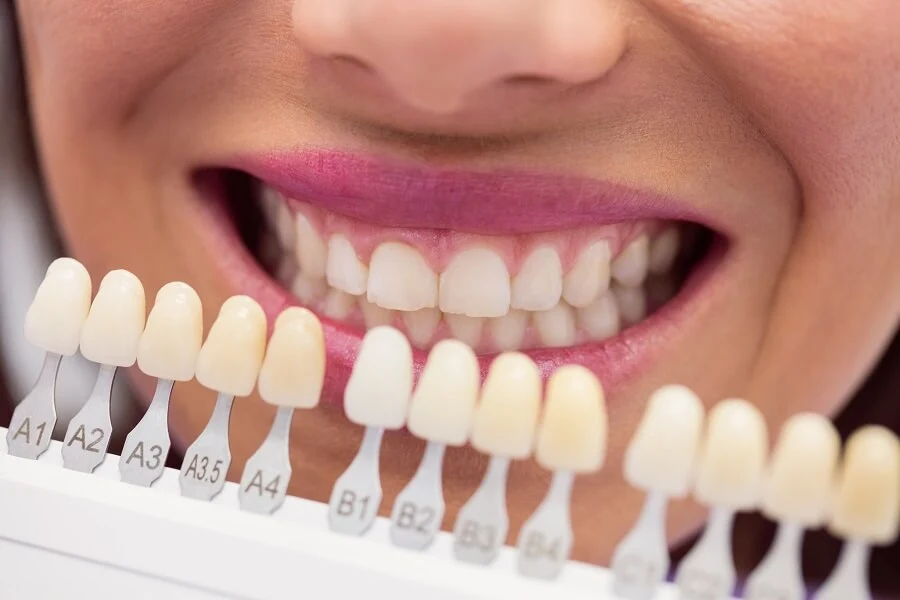Introduction:
If you’re unhappy with the way your teeth look or if you’re looking for a smile makeover for a cosmetic correction for crooked maligned teeth or badly shaped and discolored teeth, then veneers are often an excellent option.
There are primarily two types of dental veneers: Ceramic and Composite. Determining which type of veneer is right for you comes down to multiple different factors weighing down the pros and cons of each that is patient specific.
Achieving a radiant smile is a top priority for many individuals seeking cosmetic dental solutions. Among the various options available, composite veneers and ceramic veneers stand out as popular choices. If you’re in Dubai and contemplating which veneer type to opt for, this comprehensive guide will help you navigate the constant dilemma. In this blog, we will delve into the world of composite veneers and ceramic veneers, exploring their benefits, drawbacks, and suitability for obtaining that flawless smile you desire. Get ready to make an informed decision and discover the best veneers in Dubai for your smile makeover journey.
Composite Veneers:
Composite veneers, also known as direct veneers, are a popular cosmetic dental solution for enhancing the appearance of teeth. They involve the application of a tooth-colored resin material directly onto the teeth, which is then sculpted and shaped to create the desired aesthetic outcome. Here’s a closer look at composite veneers and their details:
Procedure:
The process of getting composite veneers typically involves the following steps:
a. Consultation: During an initial consultation with your dentist, you will discuss your goals, concerns, and expectations for your smile makeover. The dentist will assess your oral health, evaluate the condition of your teeth, and determine if composite veneers are suitable for your case.
b. Tooth Preparation: In most cases, minimal tooth preparation is required for composite veneers. The dentist may lightly roughen the tooth’s surface to enhance the bonding of the composite material. Unlike ceramic veneers, which often require the removal of a thin layer of enamel, composite veneers preserve more of the natural tooth structure.
c. Shade Selection: The dentist will match the shade of the composite resin material to your natural tooth color or the desired shade for your veneers. This ensures a seamless blend and natural-looking result.
d. Bonding and Sculpting: The dentist will apply the composite resin material to the prepared tooth surface in layers. Each layer is hardened using a special curing light. The dentist then sculpts and shapes the composite material to achieve the desired shape, size, and contour. This process may involve layering different shades of resin to mimic the appearance of natural teeth.
e. Finalizing and Polishing: Once the desired shape and appearance are achieved, the composite veneers are polished to a smooth and shiny finish, providing a natural-looking result.
Benefits of Composite Veneers:
Composite veneers offer several advantages that make them a popular choice for smile makeovers:
a. Affordability: Composite veneers are generally more cost-effective compared to ceramic veneers, making them a more accessible option for individuals on a budget.
b. Versatility: The resin material used in composite veneers allows for easy shaping and contouring. This versatility makes them suitable for correcting minor cosmetic flaws such as small chips, gaps, or uneven teeth.
c. Minimal Tooth Preparation: Composite veneers require less tooth enamel removal, preserving more of the natural tooth structure. This conservative approach can be beneficial for patients who wish to maintain as much of their natural teeth as possible.
Considerations and Limitations:
While composite veneers offer numerous benefits, there are a few considerations and limitations to keep in mind:
a. Durability: Composite veneers are not as durable as ceramic veneers. They may be more prone to chipping or staining over time, which can necessitate repairs or replacements. Proper care, such as avoiding excessive biting forces and maintaining good oral hygiene, can help prolong their lifespan.
b. Maintenance and Staining: Composite veneers may require regular maintenance to keep them looking their best. The composite resin material can be susceptible to staining from certain foods, drinks, and habits such as smoking. Regular dental cleanings and avoiding staining agents can help mitigate this issue.
c. Longevity: On average, composite veneers have a shorter lifespan compared to ceramic veneers. While they can last between 5 to 7 years with proper care, they may require more frequent replacement or repairs compared to the longer lifespan of ceramic veneers.
In summary, composite veneers are a cost-effective and versatile cosmetic dental option for improving the appearance of teeth. They involve the application of a tooth-colored resin material directly onto the teeth and can address minor cosmetic concerns. While they have some limitations in terms of durability and longevity compared to ceramic veneers, proper care and maintenance can help ensure they provide a beautiful smile enhancement for several years.
Ceramic Veneers:
Ceramic veneers, also known as porcelain veneers, are a popular choice for individuals seeking a transformative smile makeover. These thin, custom-made shells are crafted from high-quality dental porcelain and are designed to bond to the front surface of the teeth. Here’s a detailed explanation of ceramic veneers:
Procedure:
The process of getting ceramic veneers typically involves the following steps:
a. Consultation and Treatment Planning: During the initial consultation, your dentist will assess your oral health, discuss your desired outcomes, and determine if ceramic veneers are suitable for your case. Treatment planning involves considering factors such as tooth shape, color, and alignment to create a customized treatment plan.
b. Tooth Preparation: Before placing ceramic veneers, a thin layer of enamel (approximately 0.5mm) is gently removed from the front surface of the teeth. This is done to create space for the veneers and ensure a natural fit. Local anaesthesia may be used to minimize any discomfort during this process.
c. Impression and Shade Selection: The dentist will take precise impressions of your prepared teeth. These impressions, along with the desired shade selection, are sent to a dental laboratory, where skilled technicians fabricate the custom veneers to match your specific needs.
d. Temporary Veneers: While waiting for the permanent veneers to be created, temporary veneers may be placed to protect the prepared teeth and provide an aesthetically pleasing appearance.
e. Bonding: Once the permanent ceramic veneers are ready, the temporary ones are removed, and the dentist carefully bonds the ceramic veneers to your teeth using a dental adhesive. Special curing lights are used to harden and set the bonding material.
f. Final Adjustments: The dentist will make any necessary adjustments to ensure proper fit, alignment, and occlusion. The veneers may be trimmed or polished to achieve the desired shape, size, and color.
Benefits of Ceramic Veneers:
Ceramic veneers offer numerous advantages that contribute to their popularity in smile makeovers:
a. Aesthetics: Ceramic veneers provide exceptional aesthetics, closely resembling natural teeth. The dental porcelain used in their fabrication mimics the light-reflecting properties of natural tooth enamel, resulting in a lifelike appearance.
b. Durability and Strength: Porcelain is a highly durable material, known for its resistance to stains, chipping, and wear. With proper care, ceramic veneers can last 10 to 15 years or longer, providing a long-lasting smile transformation.
c. Stain Resistance: Unlike composite veneers, ceramic veneers have superior stain resistance. The smooth surface of the porcelain material makes it difficult for stains to adhere, ensuring a bright and vibrant smile.
Considerations and Limitations:
While ceramic veneers offer remarkable benefits, it is important to consider a few factors:
a. Cost: Ceramic veneers generally have a higher upfront cost compared to composite veneers. The advanced materials used and the expertise required for their fabrication contribute to the increased cost. However, their longevity and aesthetics often make them a worthwhile investment.
b. Irreversibility: Tooth preparation for ceramic veneers involves the removal of a thin layer of enamel, making the procedure irreversible. This aspect should be carefully considered and discussed with your dentist during the treatment planning phase.
c. Longer Treatment Time: The fabrication process of ceramic veneers in a dental laboratory can take some time, usually a few weeks. This means the overall treatment process may require multiple dental visits before the final veneers are bonded to your teeth.
In summary, ceramic veneers offer exceptional aesthetics, durability, and stain resistance, making them a sought-after choice for smile makeovers. They involve the customization and bonding of thin porcelain shells to the front surface of the teeth. While the initial cost and irreversible nature of tooth preparation are factors to consider, the long-term benefits and natural-looking results make ceramic veneers an excellent option for achieving a beautiful and confident smile.
Research reputable dental clinics specializing in cosmetic dentistry and veneer treatments in Dubai.
Read patient reviews and testimonials to gain insights into their experiences and satisfaction levels.
Schedule consultations with experienced cosmetic dentists to discuss your goals, budget, and expectations.
Inquire about the types of veneers offered, their benefits, and the dentist’s expertise in performing the chosen veneer treatment.
Discuss the maintenance requirements, aftercare, and potential costs associated with both composite and ceramic veneers.
Conclusion:
Choosing between composite veneers and ceramic veneers is a decision that requires careful consideration. The key factors to weigh include your budget, desired aesthetic outcome, durability, and long-term maintenance requirements. By consulting with a skilled cosmetic dentist in Dubai, you can receive professional guidance tailored to your unique circumstances and discover the best veneers to transform your smile. Whether you opt for composite veneers or ceramic veneers, the result will be a stunning smile makeover that boosts your confidence and enhances your dental health.
Read on the Website: The Constant Dilemma: Composite Veneers vs. Ceramic Veneers
Our Expert Doctor

Dr. Deena Jamal Harazeen
Experience : 8+ Years
Primary Speciality : General Dentist
Dr. Deena Jamal Harazeen is a highly skilled general dentist at American Medical Centre with 8+ years of experience in General and cosmetic dentistry.
She completed her Bachelors in Dentistry with Honours List and then persuade Diploma in oral Implantology and clinical training, Diploma in Porcelain-veneer course, ADAMS Certification & Clear Smile Certification. Her experience in field of Aesthetic and Cosmetic Dentistry had made her a renowned name in the field of cosmetic dentistry. She is an expert in root canal therapy, retreatment endodontics, painless dentistry, teeth bleaching, and Veneers.



